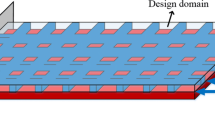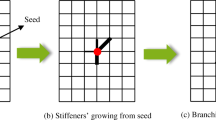Elastic buckling, which occurs in shell structures, is a major design issue because it can cause failures of structures. In particular, the variation in buckling load caused by a decrease in the thickness of the walls of structures is a key issue for safe design. The arc-length method, which is a finite element method, is generally applied to solve this type of problem. However, it has been reported that there are some cases in which the path of the buckling load cannot be solved using this method. We verified the problem by applying the arc-length method to elastic buckling that occurs in a shallow partial spherical shell. To solve the problem, we formulated a novel algorithm used in the explicit finite element method for estimating minimum strength of thin-walled structures. In this algorithm, initial deformation is given by pressing a rigid wall to the vertical direction of buckling mode. We anticipate that the proposed method will prove to be a practical way of calculating the minimum load for partial elastic buckling that occurs in a general shell structure under pressure.











Similar content being viewed by others
References
P. Radha and K. Rajagopalan, “Ultimate strength of submarine pressure hulls with failure governed by inelastic buckling,” Thin-Walled Struct., 44, 309–313 (2006).
N. C. Huang, “Unsymmetrical buckling of thin shallow spherical shells,” J. Appl. Mech., 31, 447–457 (1964).
G. A. Thurston, “A numerical solution of the nonlinear equations for axisymmetric bending of shallow spherical shells,” J. Appl. Mech., 28, 557–561 (1961).
M. Cerini and B. G. Falzon, “The reliability of the arc-length method in the analysis of mode-jumping problems,”in: Proc. 44th Conf. on Structures, Structural Dynamics, and Materials, Norfolk, VA, AIAA (2003), pp. 1977–1986.
R. Kao, “Large deformation elasitic-plastic buckling analysis of spherical caps with initial imperfections,” Comp. Struct., 11, 609–619 (1980).
T. Y. Yang and D. G. Liaw, “Elastic-plastic dynamic buckling of thin-shell finite elements with asymmetric imperfections,” AIAA J., 26, No. 4, 479–486 (1988).
T. Koga and N. J. Hoff, “The axisymmetic buckling of initially imperfection complete sphrical shells,” Int. J. Solids Struct., 5, 679–697 (1969).
A. Kaplan and Y. C. Fung, A Nonlinear Theory of Bending and Buckling of Thin Elastic Shallow Spherical Shells, NACA Technical Note 3212, August (1954).
R. H. Homewood, A. C. Brine, and A. E. Johnson, Jr., “Experimental investigation of the buckling instability of monocoque shells,” in: Proc. of the Society for Experimental Stress Analysis, Vol. 18 (1961), p. 88.
B. Budiansky, “Buckling of clamped shallow spherical shells,” in: Proc. of the Symposium on the Theory of Thin Elastic Shells (Delft), North Holland Publishing Co., Amsterdam (1959), p. 64.
M. A. Crisfield, “Snap-through and snap-back response in concrete structures and the dangers of underintegration,” Int. J. Num. Meth. Eng., 22, 751–767 (1986).
Author information
Authors and Affiliations
Corresponding author
Additional information
Translated from Problemy Prochnosti, No. 2, pp. 125 – 134, March – April, 2012.
Rights and permissions
About this article
Cite this article
Ishinabea, M., Hayashib, K. An algorithm for estimating minimum strength of thin-walled structures to resist elastic buckling under pressure. Strength Mater 44, 205–211 (2012). https://doi.org/10.1007/s11223-012-9373-6
Received:
Published:
Issue Date:
DOI: https://doi.org/10.1007/s11223-012-9373-6




